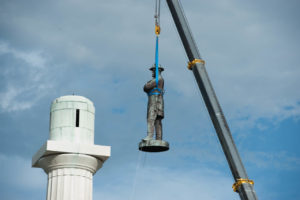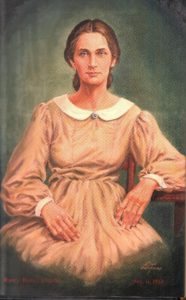 A week ago I wrote a post titled, “The Rational Case for Removing Confederate Monuments.” There were a couple of important comments that I addressed on that post, but one in particular that I would like to address here – Do we ‘erase history’ by removing confederate monuments?
A week ago I wrote a post titled, “The Rational Case for Removing Confederate Monuments.” There were a couple of important comments that I addressed on that post, but one in particular that I would like to address here – Do we ‘erase history’ by removing confederate monuments?
The short answer is no, but the longer answer reveals that this question is more complicated. In fact, the question is really two questions: First, do Confederate statues accurately reflect history? Second, does removing statues disable us from learning history? Keep in mind that when I say monuments I include Confederate statues as well as naming schools, army bases, and roads after Confederate generals and political leaders.
As I noted in my original post, the history that these monuments honor is a false history, which is commonly referred to as “The Lost Cause.” Confederate monuments were a concerted attempt to rewrite history to deny slavery’s role in antebellum America and its fundamental causation of secession and the Civil War. Erecting Confederate monuments joined with Jim Crow laws and intimidation by white supremacist groups like the KKK to both undermine the voting rights of African Americans and promote a white superiority political power structure.
Why? One reason is inherent in the paragraph above – to maintain white-dominated political, social, and economic power. Prior to the Civil War the South was dominated by a plantation economy based on the existence of slave labor. Small farmers were bought, or forced through intimidation, out of the cotton market (as well as tobacco and sugar markets) because they couldn’t compete with huge plantations. This put all economic and political power in the hands of the wealthy few. Since vast acreages of cotton required significant manual labor, Americans of African origin were held in enslavement and forced to do the work. For a variety of reasons, this slave-labor based economic system grew in the South while diminishing in the North. Compromises in the Constitution, in 1820, and in 1850 tried to limit the spread of slavery as the geographic area of the United States expanded (because of the Louisiana Purchase and Mexican War, for example) while also securing continuing rights of slaveowners in those states in which slavery existed. The Kansas-Nebraska Act in 1854 and Dred Scott decision in 1857 gave more power to slave states, again focused on the power of wealthy plantation owners. With the near-election of John C. Fremont in 1856 and the actual election of Abraham Lincoln in 1860, these wealthy plantation slaveowners felt that slavery was in danger. Worse, they saw that potential racial equality would eliminate their white superiority power structure. Thus, the slaveholding states decided to secede and go to war to protect and expand slavery, and along with it, their belief that whites were superior to blacks. That perceived racial superiority continued to drive actions to disenfranchise black rights as guaranteed in the 13th, 14th, and 15th amendments.
But there is a second reason for why the Lost Cause mythology caught hold, and why the United Daughters of the Confederacy and others focused on erecting statues in the early 20th century. As with most Americans, I am rightly proud of my father’s service in World War II. Others are proud of their own personal or family service in fighting for our nation. But consider the position of sons and daughters of Confederate veterans. Their fathers fought in a war to break up the United States and expand the right to enslave other people. True, most rank and file soldiers were probably not slaveowners themselves and may not have even been all-in on the idea of the war (which is why their leaders lied to soldiers, telling them it was a “war of northern aggression”), but to some extent their descendants must have felt similar to what the sons and daughters of Nazi soldiers felt in the decades following WWII. We all want to honor the bravery of our ancestors. The Lost Cause fabricated a mythology that allowed us to honor them. Even today there are many members of Civil War roundtables who proudly trace their heritage back to Confederate soldiers. Now, I’m going to stop here on this particularly topic because it requires a much deeper dive into history that I’ll attempt in a future post. I’ll leave by saying that I think people today should still warmly regard their ancestors that fought in the rank-and-file for the Confederacy. They should do so with a full understanding of the history, both of the Civil War (including pre- and post-) and their ancestors’ specific circumstances. I highly encourage genealogy and historical studies on both sides of the conflict.
To summarize this first part of the question – Confederate monuments do not accurately reflect our history. Instead, their purpose is to deflect from actual history and create a feel-good alternative, and false, history.
Which gets us to the second part of the question: Does removing statues erase history, or perhaps better put, keep us from learning and understanding history?
In fact, removing Confederate statues may actually allow us to better understand our history. Once these monuments to a false history are removed, we can focus on doing a better job of communicating our actual history. In essence, the monuments distract us from learning history by replacing it with a political and social debate. A more accurate view of our history would need to include an honest discussion of the dominant role of slavery from our Constitution through the Civil Rights acts and beyond. It would require an accurate recounting of the pervasiveness of slave-based economic system, including the relationships between cotton plantations of the South, financiers and shipbuilders of New York, and the textile mills of New England. With respect to specific monuments, here is what I wrote in response to a comment on my original post:
As for “real historical information,” most would define that as accurate and complete history of individuals and the times. For example, Robert E. Lee might include his service in the United States Army prior to rejected the Union and fighting for the Confederacy to protect and expand slavery. His time after the war as president of Washington College (renamed Washington and Lee after his death) might be relevant if any of his actions were relevant to his standing. Nathan Bedford Forrest’s history would obviously included his Confederate Army service, as well as his roles in the murders of black Union troops (USCT) at Ft. Pillow and elsewhere, as well as his role as grand dragon of the KKK. In all cases, the full story would need to be told.
All of this and more would be necessary for us to gain a fuller understanding of our shared history.
So does this mean that all Confederate monuments should come down? Maybe. Or maybe not. The goal here is to encourage a rational debate on the fate of Confederate monuments, but also in a larger sense, a discussion of our often complicated and not-always-admirable history. Rather than call for feel-good propaganda – a hallmark of fascist and authoritarian states, not democracies – we should be calling for a more complete understanding of the principles and actions of our nation. Individual statues might remain or moved or provided with additional context. A rational discussion of Confederate monuments can help us communicate the realities of our history to the public such that the public can make more informed and rational choices. The more we can do this proactively, the less we’ll see of uninformed mob action.
This process has another benefit. The discussion may help us come closer to the Founders’ ideal of “all men are created equal” endowed with the unalienable rights of “life, liberty, and the pursuit of happiness.” The goal isn’t to remove anyone’s rights but to ensure the rights imbued by our Constitution apply to ALL Americans.
I’ll continue with future posts addressing other rebuttals or concerns to my original post outlining a rational case for removing Confederate monuments. If you have any thoughts, either in support or refutation of what I’ve written, feel free to leave a comment below and I’ll do my best to provide a response. As always, any rational and respectful comment will be addressed. Non-respectful, racist, or vulgar diatribes will not. The goal here is rational dialogue.
[Photo credit: (Abdazizar/Via Wikimedia Commons)
David J. Kent is an avid traveler, scientist, and Abraham Lincoln historian. He is the author of Lincoln: The Man Who Saved America, Tesla: The Wizard of Electricity and Edison: The Inventor of the Modern World as well as two specialty e-books: Nikola Tesla: Renewable Energy Ahead of Its Time and Abraham Lincoln and Nikola Tesla: Connected by Fate.
Check out my Goodreads author page. While you’re at it, “Like” my Facebook author page for more updates!





 The recent pressure to remove Confederate statues has spilled over into monuments to other historical figures, most incredibly including
The recent pressure to remove Confederate statues has spilled over into monuments to other historical figures, most incredibly including  Nancy Hanks Lincoln died October 5, 1818 of “the milk sick.” Or did she? While Abraham Lincoln biographers generally attribute her death to milk sickness, a possibility exists that it might have actually been something else. The story goes like this:
Nancy Hanks Lincoln died October 5, 1818 of “the milk sick.” Or did she? While Abraham Lincoln biographers generally attribute her death to milk sickness, a possibility exists that it might have actually been something else. The story goes like this:






